Every art movement has its lifecycle, a fact that is as applicable to culinary movements as to other aesthetic domains. The middle of the first decade of the Twenty-First century will be remembered as a time of triumph for the Molecular Movement, a trend that I termed Agape Cuisine for its carnal desire to astonish through the creation of new techniques of preparation that taken together had the goal of astonishment. This was the El Bulli moment, a moment that was supported and extended by world-class restaurants such as the Fat Duck and Alinea and El Celler de Can Roca and WD-50 and Moto. But where are we today? What is left after the nitrogenated dust has settled?
Such a question is properly asked in the dawning of this new decade because of El Bulli’s recently announced closure, the new directions (and restaurants) of Heston Blumenthal (in Dinner) and Grant Achatz (in Next) and the incorporationist movement of other chefs and the prominence of some restaurants (Noma, Coi) such as those that some bloggers have termed the New Naturals with chefs as hunter and gatherers and others, such as Chef Josh Skanes at San Francisco’s Saison or Chef John Shields at Virginia’s Town House, experimenting with cooking in ash. It’s back to the future.
Ultimately all art worlds (and the world of high-end cuisine must be conceived of as an art world) have their styles and fashions, and these styles and fashions can be analogized to scientific fashions, as discussed within the sociology of knowledge. When old techniques stop working or stop appealing to an audience, there is a space for a change. We are always looking out for the “next new thing.” We hope to be first movers, revealing what is hot and what is cool. This was brought home to me in a recent visit to Barcelona to dine at two of the world’s great restaurants, the estimable El Celler de Can Roca (in Girona) and “the restaurant at the end of the universe” El Bulli (in Roses).
I was fortunate to dine at El Celler de Can Roca two years ago and, although I was an EB virgin, I dined with a multiple-time diner at El Bulli. Neither chef (Chef Joan Roca or Chef Ferran Adria) has forgotten the techniques that he had pioneered and that brought fame. Both meals were filled with creative nummies. But each seemed to recognize that cuisine is built on a classical foundation. Perhaps this is not Escoffier’s Paris 1906 as Grant Achatz will replicate in Chicago’s Lincoln Park, but it recognizes that new techniques take us only so far, they need to be integrated into the canons of taste. Sauces are there for the rediscovery.
A view of photos from El Bulli reveals distinctive and joyous dishes, but nothing from a different universe, and this is not bad. Adria’s shrimp on a tortilla, wonderful and distinctive, was not mad. The other shrimp dishes were even more classical. Perhaps woodcock is not typically served with guanabana, but it doesn’t take a chemist to figure out how to do so. The San Felicienne cheese blini was as classic and as buttery as could be requested. The quails with escabeche, wonderful and precise, were remarkable in a way that is within the canon of classic cuisine (even if perhaps cooked sous vide). Even the olive oil chip relied on one of Adria’s old-new techniques. Some surprises remained, but nothing that demanded a new vision.
The same should be said of the meal at El Celler de Can Roca. The caramelized olives were wonderful, as was the herbal green colourology dessert, the mullets with stew, the steak tartare with mustard ice cream, and the oysters with cava. All of this was definitely modern cuisine in its best sense, but it no longer seemed straining for effect. Three years ago I was startled and amazed; this year I enjoyed.
So at this moment we seem to be at the ending of a phase of an aesthetic revolution in which chefs – the best ones and the new ones – are rethinking what needs to be saved and what jettisoned to produce delightful dishes.
There is a necessary and joyous tension – a dialogue – between cuisines based on simplicity and nature (the new naturals, “snout to tail dining” and “farm to table” cuisine) and those based upon novel elaborations and techniques (the family of molecular cuisine). With the attention that has been given to new methods, there is a recognition that the past has virtues as well. And so we find Chrono-cuisine, as chefs like Grant Achatz (at Next) and Heston Blumenthal (at Dinner) mine the past, remembering the forgotten.
Chefs are at an inflection point. Molecular cuisine is yesterday. And Yesterday is tomorrow.
And to the El Bulli meal (photos of El Celler de Can Roca on on the previous post). We were served 42 courses in this last year of El Bulli on a menu that emphasized winter provisions, such as black truffles and game (hare and woodcock). I was impressed in examining Josh's photos and from comments by those who had dined at El Bulli before that the meal was less experiment, but almost restrained. It was not that there were no molecular dishes, but some of the striving for the new was less evident. Yes, this was a version of "cuisine agape," a cuisine of amazement, but simultaneously it spoke to traditions in cuisine. Even Adria's new found classicism is not Escoffier's as Grant Achatz may soon demonstrate. Actually I have come to prefer dishes that are astonishingly simply, rather than those that strive for aerial acrobatics. Of the 42 courses, I would not wish to taste all again (there tofu tiramisu I could do without and the sugar cane was less than compelling), but other dishes were evocative and will live as long as I do in my memory. Ferran Adria is one of the few true geniuses in the culinary world (Grant Achatz is another), even when his ideas do not pan out.
With forty-two courses the meal permitted sets of courses, creating musical variations on a theme: we had a set of mojito courses, a set of shrimp courses. nut courses, truffle courses, Mexican courses, and game courses. And sometimes we would revisit a theme. I have had better courses, but with a very, very exceptions, never a better meal. With fifty cooks, twenty-five servers, and fifty diners, service was splendid. One of the eight of us could not eat raw fish or shellfish, meat, or liquor. For many restaurants this would be a problem. But her forty-two courses (about half were different) were just as proficient as ours. As is evident, Adria is not a star when it comes to plating - only a few dishes are beautiful on the plate and some are (perhaps deliberately) sloppy - he cares about the theory of taste, the idea of the gustatory senses. In that he is the master.
Even with 42 courses and 6 bottles of wine (for seven of us), we were not stuffed after five hours (but no pizza on the way home)


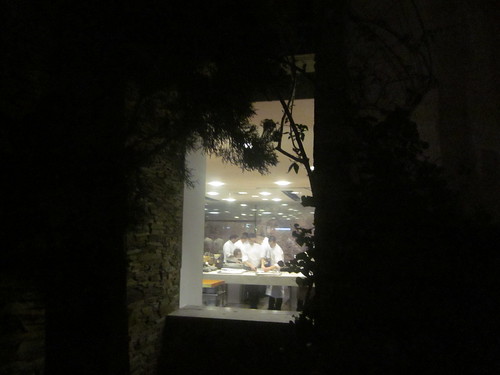
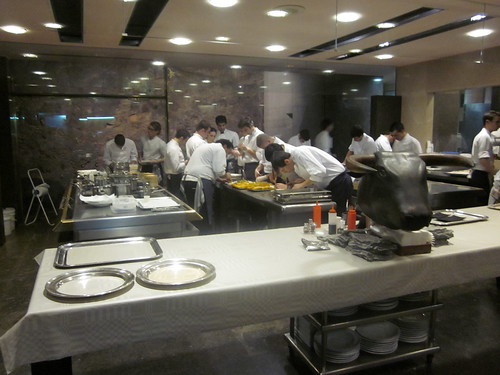
Here is the man himself greeting his guests
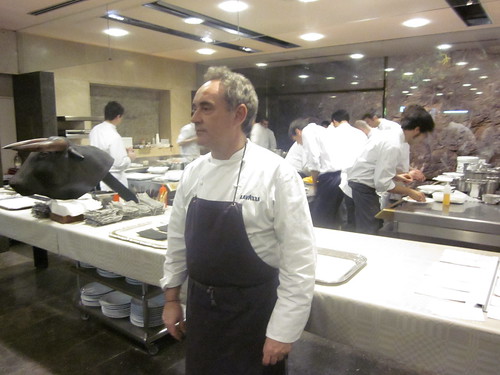
Ginger and Lime Candi. An elegant start to the mojito theme.
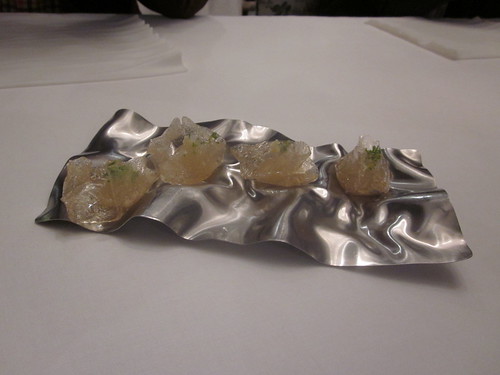
A warm and minty mojito
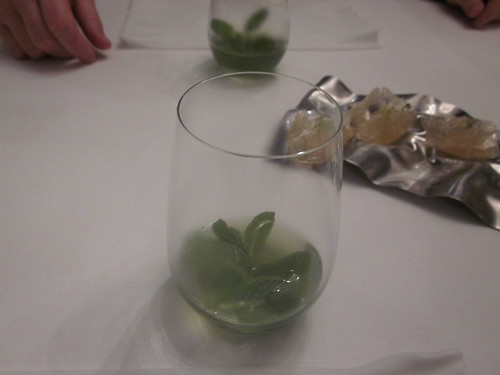
Mojito 3.0 - a mojito sandwich (mojito and apple flute), very playful

Moving from mojito to nuts with the almond fizz with amarena.

Nori Seaweed with Lemon. A beautiful dish using ingredients that would challenge other chefs.
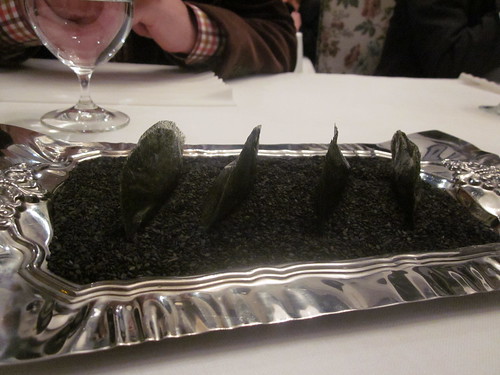
The olive oil chip was masterful. So was the parmesan macaron. It could be found nowhere but El Bulli.
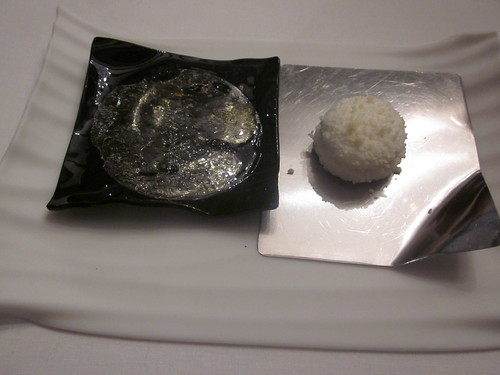
Peanut and honey roll. An early dessert - and an ode to nuts
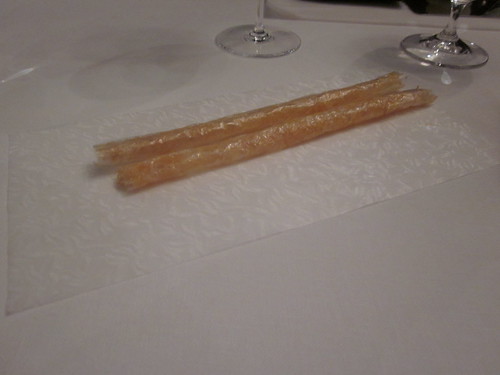
Hibiscus and Peanut. Tropical and inviting. More nuts, and the start of the Latin theme.
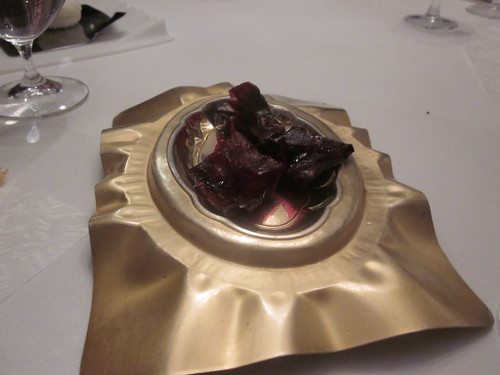
Pistachio ravioli. As good a ravioli as I have had. Nuts!
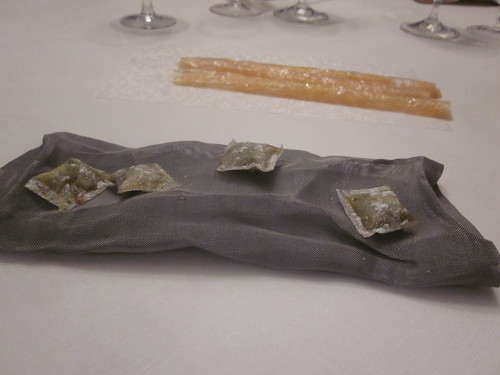
Shrimp torilla. One of Adria's best dishes. Simple and so clever and so shrimpy. Beautiful. I won't forget this, ever.
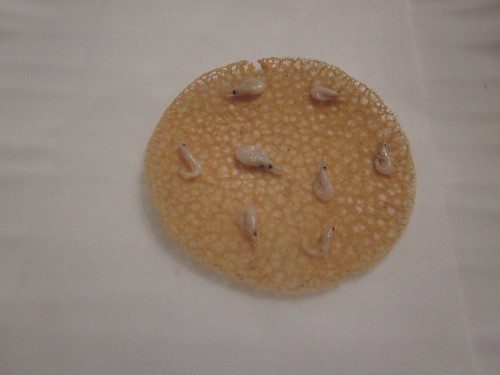
Classic shrimp.

The third (and fourth) shrimp - a prawn with an intense "soup"
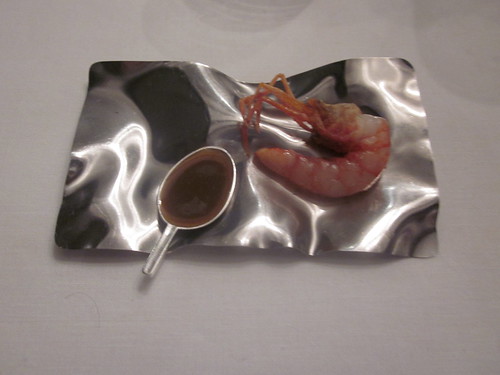
Quails with Carrot Escabeche. Another amazing and simple dish. Four dabs of carrot and one dab of peppery carrot (it is number four). Wonderful.
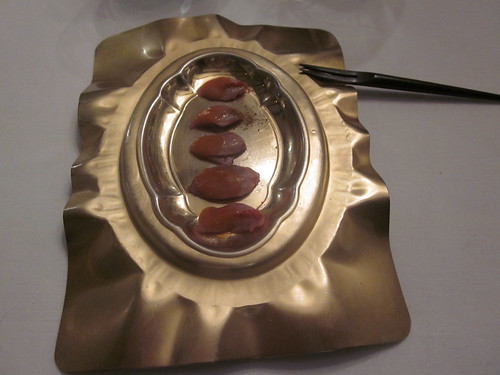
Tomato Tartare. A pure palate cleanser
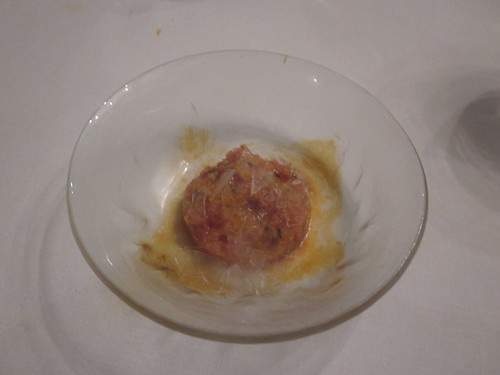
Soya Tiramisu. My least favorite - a bit of a mess, and not pretty. There has to be one worst dish. It just didn't sing.
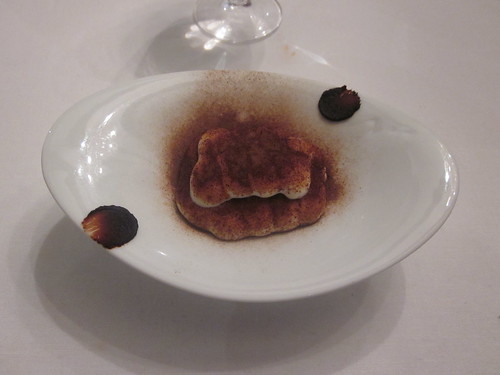
Soya Matches. A much better use of soy, each bite had a distinct taste: how did he do this?
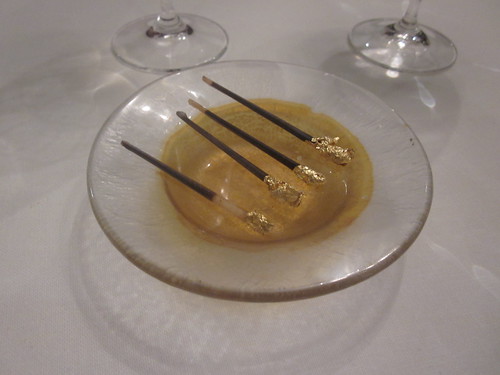
Ferran at his most playful: caviar with hazelnut cream. Hazelnut caviar with caviar cream. A very Fat Duck/Moto playful dish. A laugh riot. I wouldn't have it again, but I will talk about it endlessly.
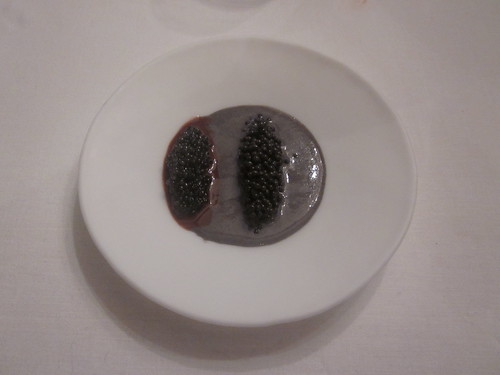
Liquid Hazelnut Porra. Very pleasant "bread" stick, hazelnut style.
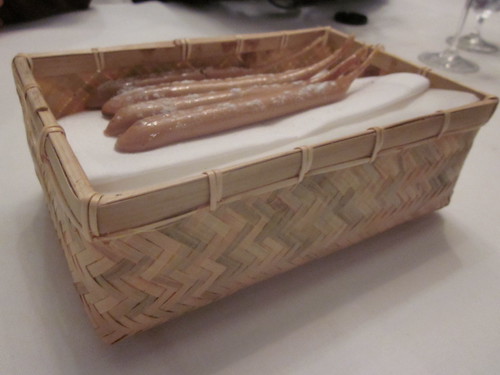
Truffle cake. Wow. As truffly as things get. The texture matched the dark intensity of the fungus. A great and extravagant use of the black truffle.
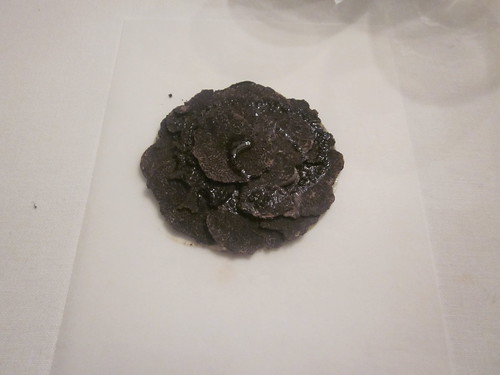
Endive in Papillote 50%. A play on fish cuisine with endive. A good and light dish.
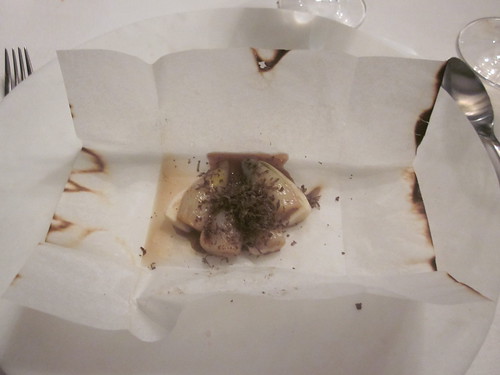
Foie Cake. In contrast to the above dish, an uber-rich cake.

San Felicienne (cheese) Blini. Simple. Classic. And as good as cheese gets in the hands of a master.
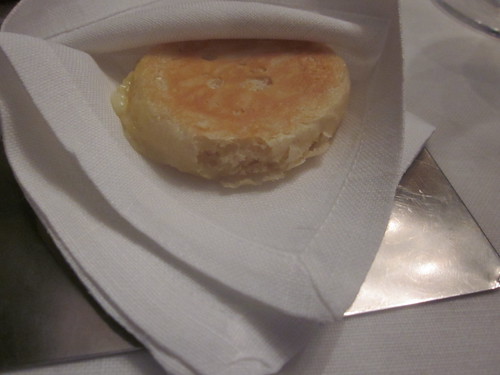
Steamed eels. Fun as a quicky. I prefer eels more robustly prepared, but it was an aquatic palate cleanser.
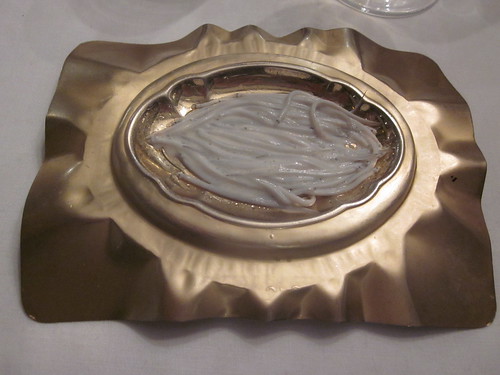
Lulo Ceviche and Mollusk. A dish of sublime complexity. Part of the Latin sequence
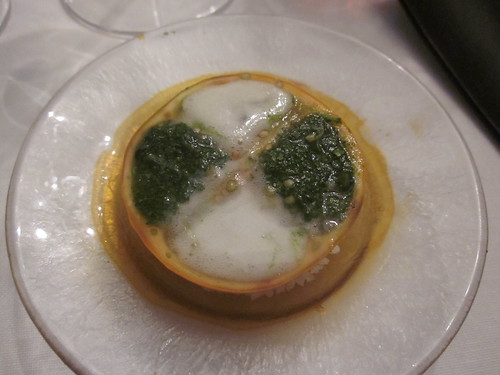
What a beautiful dish. Iced gazpacho with prime olive oil. Adria removes all of the color (how?), but leaves in all of the taste. It would be the best dish in July, and pretty amazing in February.
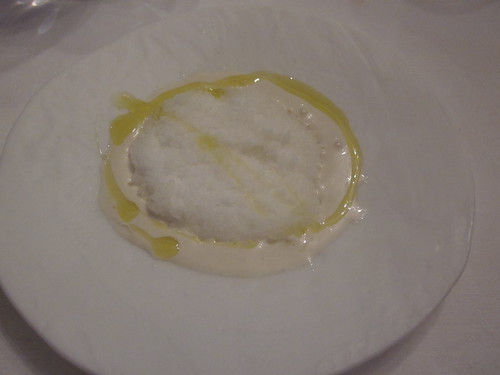
Hare Bunuelo. The bridge between the Latin courses and the game courses. A bite size treasure.
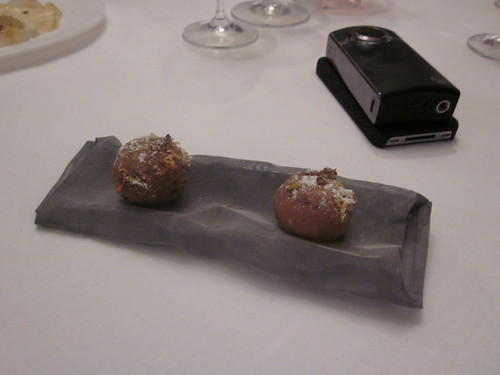
Game Meat Capuccino. Soup Starbucks style - finally foam. Note the absence of form (and other oddities) in the rest of the meal.
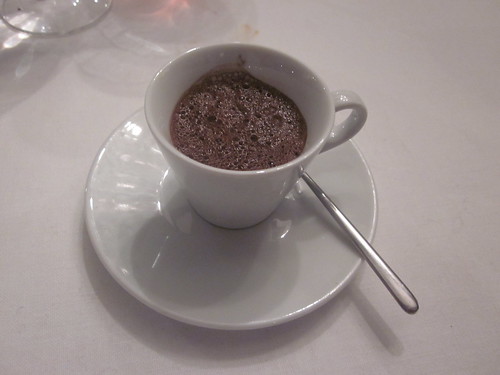
Peas Two Ways. A vegetable dish for a diner who didn't eat meat. I just thought it was so pretty - but not a great photo. (It wasn't part of the game sequence)

Woodcock and fruit (with a Latin twist with soursop): lovely dish. The best of the game offerings.
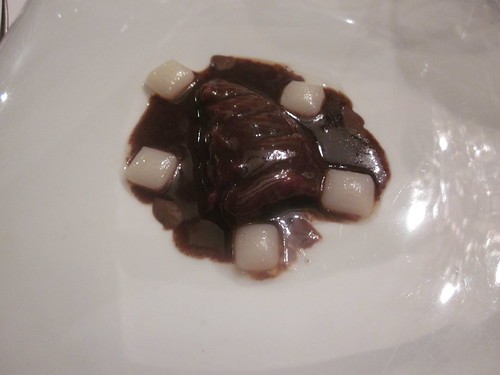
Blackberry Risotto with Game Meat Sauce. Another fruit and game special. A strong dish as well.

Hare Ravioli with Bolonesa (and Blood). Very intense dish. A fine taste of the wild. Traditional, but also El Bulli style
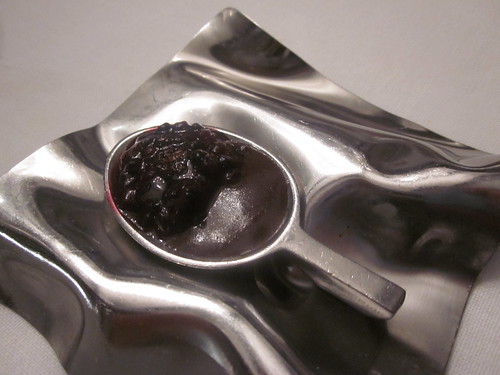
Hare Cocktail with Raspberry. Another in the set of game "soups" with fruit.
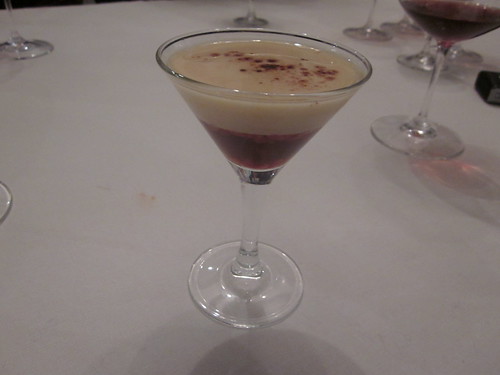
Hare Chestnut with Liver Puree. Finally game and nuts - wrapped up in a delicious package. Perfect for snacking.

Pandang Ice Cream with Coconut Water. Another treat and trick. One of the jelly beans is salty: a reprise of the quail dish. The best dessert.
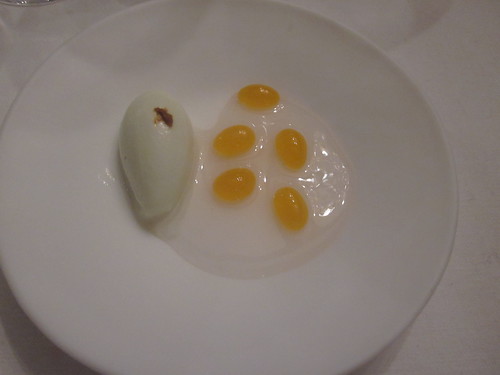
Sugar Cubes with Lime Whiskey Sour. OK. A palate cleanser. A mojito reprise.
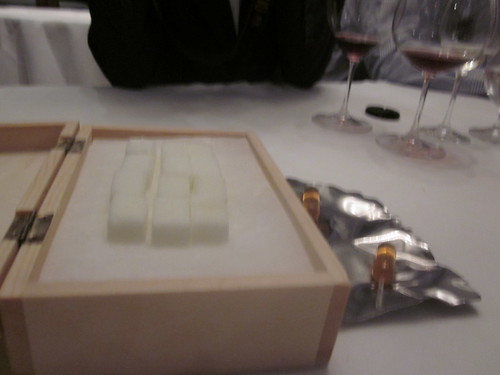
Rum Sugar Cane. A second palate cleanser.
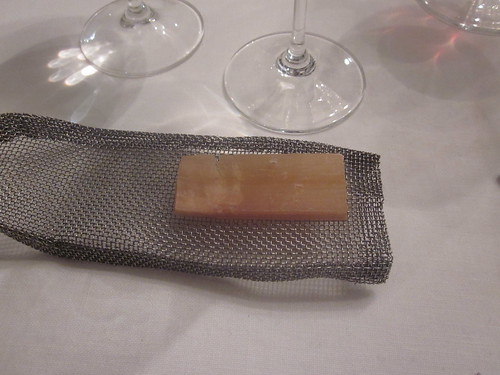
Mini-Donuts with 97% Pure Chocolate. Powerfully bitter and sweet. Can chocolate taste so intense?
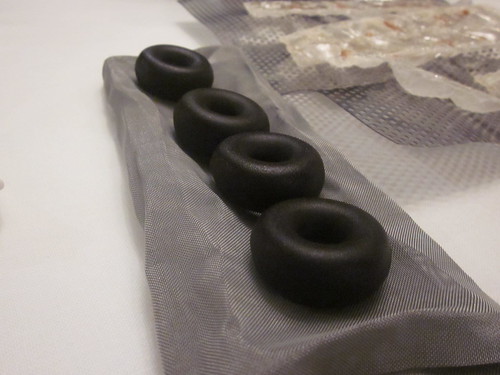
Coca de Vidre - Crystal Cake - Coconut and Pine nuts. A very enjoyable sweet. It went down easily and quickly

Gold Leaves in Coffee-Chocolate Soil. A strong way to wrap up, reminding us that despite the nods to classicism, Chef Adria created much of modern cuisine that we take for granted.
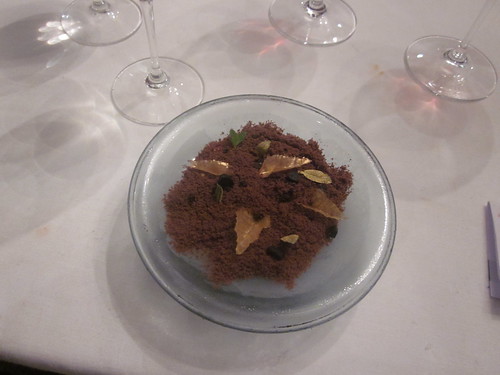
The finale! The box! The freeze dried strawberries were particularly notable as was the passionfruit-yogurt sponge
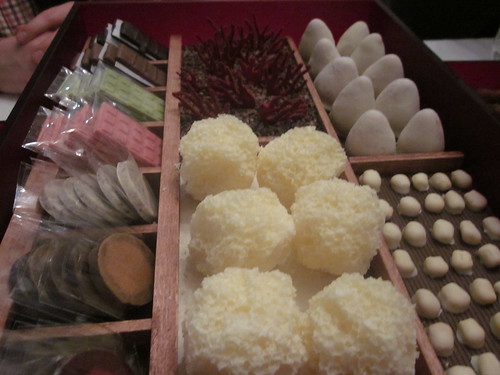
El Bulli
Roses, Spain

No comments:
Post a Comment